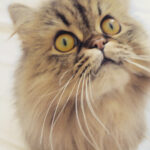Witnessing your cat breathing with their mouth open can be alarming. While panting is normal for dogs, it’s often a sign of an underlying health issue in cats. This condition, known as dyspnea, or respiratory distress, indicates that your feline friend is having significant difficulty breathing. It’s crucial to recognize the signs of dyspnea and seek veterinary help immediately.
Dyspnea, derived from Greek words meaning “difficulty breathing,” isn’t a disease itself but a clinical sign. Veterinarians use this term, or the more descriptive “respiratory distress,” to describe labored breathing in cats. Essentially, it means your cat is struggling to inhale and exhale properly. Understanding why this happens is the first step in ensuring your cat receives the care they need.
Recognizing the Signs of Dyspnea in Cats
Beyond simply breathing with an open mouth, cats experiencing dyspnea may exhibit several other noticeable symptoms. Keep an eye out for these signs that may accompany open mouth breathing:
- Rapid Breathing: An increased respiratory rate, significantly faster than their normal breathing.
- Noisy Breathing or Panting: Breathing may sound louder than usual, and they might pant audibly, often with their mouth open.
- Coughing: Frequent coughing, which may sound different from a hairball cough.
- Changes in Posture: Cats may lower their head, extend their neck and body forward, and sometimes appear to be gagging or retching, as if trying to vomit.
Dyspnea can develop suddenly (acutely) over a few hours or gradually (chronically) over weeks or months. Regardless of the onset, any sign of labored breathing warrants prompt veterinary attention.
Common Causes of Open Mouth Breathing and Dyspnea
The reasons behind dyspnea in cats are diverse, ranging from minor irritations to serious medical conditions. Some potential causes include:
- Feline Asthma: Similar to human asthma, this condition causes inflammation and narrowing of the airways in the lungs, making breathing difficult.
- Heart Failure: Congestive heart failure can lead to fluid buildup in the lungs (pulmonary edema), hindering oxygen intake and causing respiratory distress.
- Pleural Effusion: This refers to the accumulation of fluid in the space between the lungs and the chest wall. The fluid compresses the lungs, making it hard for them to expand fully.
- Upper Respiratory Infections: Viral or bacterial infections can cause inflammation and congestion in the nasal passages and airways.
- Foreign Bodies: Objects lodged in the nasal passages or windpipe can obstruct airflow and lead to breathing difficulties.
- Lung Tumors or Pulmonary Disorders: Various lung conditions, including tumors, can impair lung function and cause dyspnea.
- Trauma and Injuries: Chest injuries can directly affect the lungs and breathing mechanics.
According to veterinary experts, the most frequent causes of respiratory distress in cats are asthma, heart failure leading to fluid in the lungs, and pleural effusion. Identifying the specific cause is crucial for effective treatment.
Risk Factors for Breathing Difficulties
Risk factors for dyspnea are linked to the underlying conditions that cause it. For instance, heart-related dyspnea is more common in older cats due to the increased risk of heart disease with age. Asthma, while possible in cats of any age, might be more prevalent during warmer seasons with higher pollen counts. While obesity itself isn’t a direct cause, it can worsen breathing difficulties and make them progress faster in overweight cats.
The Urgency of Veterinary Care for Cats with Dyspnea
Dyspnea is a critical clinical sign, not a diagnosis in itself. Its progression and outcome depend entirely on the underlying disease causing the breathing problem. However, any cat showing signs of breathing difficulty is at serious risk. Without prompt treatment, respiratory distress can be life-threatening.
Veterinary intervention is essential to diagnose the root cause of dyspnea and initiate appropriate treatment. Treatment varies depending on the diagnosis. For asthma, bronchodilators are typically used to open up the airways. Pleural effusion often requires draining the excess fluid from around the lungs.
If you observe your cat breathing with their mouth open or displaying any signs of respiratory distress, immediate veterinary attention is paramount. Attempting home remedies is strongly discouraged. A veterinarian is equipped to conduct a thorough examination and perform necessary tests to determine the cause of dyspnea and provide the right treatment to help your cat breathe easier.

